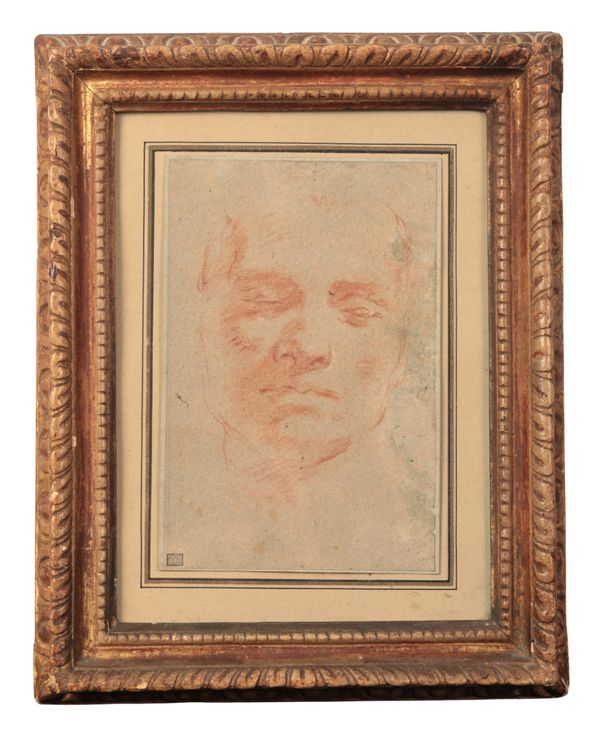red chalk, heightened with white chalk, on blue paper, collector’s mark ‘WB’ for William Bateson lower left, 20cm x 13.25cm
Provenance: The Collection of William Bateson (1861-1926), English biologist and evolutionary theorist,
His sale, London, Sotheby’s, Important Drawings by Old Masters of the Italian, Dutch, Flemish, French and English Schools, 24 April 1929
An Artistic Family Collection, Wiltshire.
| Condition Report: | click here |
| Estimate: | £10,000 - £20,000 |
| Hammer price: | £8,000 |
Giovanni Battista Tiepolo
Born in Venice in 1696 to a prosperous merchant, Giovanni Battista (Giambattista) Tiepolo chose to pursue a career in painting. He was taught by Gregorio Lazzarini (1655-1730), studying under him probably c. 1710. In 1717 he was inscribed in the Venetian painters guild as an independent painter. His earliest dateable works, in the Ospedaletto, Venice (1715-1716), do not display the classical compositions and smooth finish characteristic of Lazzarini's paintings, but rather the avant-garde tenebrism of Federico Bencovich (1677-1726) and Giovanni Battista Piazzetta (1683-1754). Much controversy surrounds the course of Tiepolo's development in the next fifteen years in which there are few dated paintings. Knowledge of his activities in the teens and twenties comes mostly from Vincenzo da Canal's biography of Lazzarini (1732), in which the author devoted several pages to the talented pupil whose popularity had soared in the previous decade. During these early years Tiepolo experimented with various styles simultaneously, and recent scholarship based on da Canal's listing of Tiepolo's paintings prior to 1732 has shown that the artist vacillated between the tenebrism practiced by many Venetian contemporaries and a lighter, more atmospheric style. As early as c. 1716 Tiepolo was practicing the art of fresco painting on the terrafirma, a technique reintroduced into the Veneto in the late sixteenth century by non-Venetian artists. His grandest decorative cycle of the period, painted for the Archbishop's Palace in Udine (c. 1726-1729), reveals his interest in Veronese's colour and compositions.
Tiepolo's frescoes in Udine brought him immediate fame and commissions for further decorative ensembles. In the next ten years he painted and frescoed in palaces and villas in and around Milan, Bergamo, Venice, and and elsewhere in the Veneto, the subjects of which derive mostly from ancient history. With the Bolognese quadrattura painter Girolamo Mengozzi-Colonna (c. 1688-c. 1766), who designed his architectural surrounds, Tiepolo revolutionised the art of fresco decoration in Venice by combining the deep perspective of Venetian cinquecento ceiling decorations with a compositional clarity that connected the diverse elements of the design into a greatly expanded pictorial space. Unlike their direct precedents in which forms were arranged haphazardly across the ceiling, Tiepolo's compositions are ordered in zig-zag patterns that expand the illusionistic view into the heavens. By 1740, after conquering towering church ceilings such as the Gesuati, Venice (1737-1739), with this method, he brought figures closer to the spectator in long, low secular rooms by distributing his deeply coloured figures along the cornice and contrasting them with increasingly lighter pastel hues in the open skies (Palazzo Clerici, Milan, 1740). In the same years Tiepolo developed as an artist of religious altarpieces, in which he captured counter-reformatory devotional images in a neo-Renaissance format.
Tiepolo's fame and prices increased further in the 1740s. He moved several times during his career, always to grander quarters, which he shared with his wife Cecilia, the sister of Francesco Guardi and their nine children. The artist had already rejected an invitation to Sweden in 1736, and now his paintings were being requested in northern Europe. His friendship with Francesco Algarotti (1712-1764), whom he met in 1743, brought him commissions from the Saxon court of Dresden. Although always inspired by ancient history, in this period Tiepolo turned increasingly to representations of antique monuments and dress. At the same time, he took up etching, producing two sets of prints--the Scherzi di fantasia and the Capricci--both heavily laden with antique references.
External political forces kept foreigners from Venice in the second half of the 1740s, causing an economic slowdown in the city and compelling Venetian artists to seek employment abroad. Although Tiepolo was so active in this decade that he enlisted the help of his son Giovanni Domenico (Giandomenico, 1723-1804), he nevertheless accepted the lucrative invitation to work for Prince Bishop Carl Philipp von Greiffenklau of Würzburg in the archiepiscopal palace, where he resided from late 1750 to 1753. There he produced what is considered his greatest triumph, the enormous ceiling fresco in the grand staircase with Olympus and the Four Continents (1752-53). Another son, Lorenzo (1736-1777), less talented than Giandomenico, also accompanied his father to Würzburg as a helper.
In the 1740s and 1750s, Tiepolo's expanded repertoire included literary, historical, mythological, allegorical, as well as religious works. He continued to produce masterpieces in both Venice and the Veneto, such as the story of Antony and Cleopatra in the Palazzo Labia, Venice (1746-1747), and the scenes from Tasso in the Villa Valmarana, Vicenza (1757). Commissions from abroad continued: Tiepolo sent works to the kings of France and England and the Czarina of Russia. In 1761, King Charles III of Spain requested Tiepolo's services to paint in the newly completed Royal Palace in Madrid. Due to political pressures and in spite of his age and illness from the gout, Tiepolo set off on his last journey in 1762. Although his large ceiling fresco for the Throne Room in the Royal Palace, Madrid (1762-1764) has been criticised as a reworking of earlier compositions, its breadth and sophistication mark it as one of his late successes. His altarpieces for San Juan Baylon at Aranjuez (1767-1769) reveal an old age style of simply presented but deep religious meditation and emotion.
About the time of Tiepolo's death in Madrid in 1770, the taste for dramatic allegorical subjects and passionate religious themes had faded throughout Europe in favour of a severe neo-classical style that reflected the new rationalism of the period. By the end of the century, with the fall of monarchic power and lessening influence of religious institutions, Tiepolo's art was outdated. Even his son Giandomenico had taken up more objectively motivated themes and a realistic style. In spite of this, Tiepolo is recognised today as one of the most brilliant and celebrated artists of the eighteenth century and the last of the great practitioners of the Renaissance and baroque tradition.
Paper laid atop a backing sheet, some nibbles to the paper lower right. UV light showing lighter areas to the right hand side (pics available). Backing paper appears affixed to the mount at the corners only, so the work is not laying entirely flat. Frame with minor losses and some woodworm holes verso.

